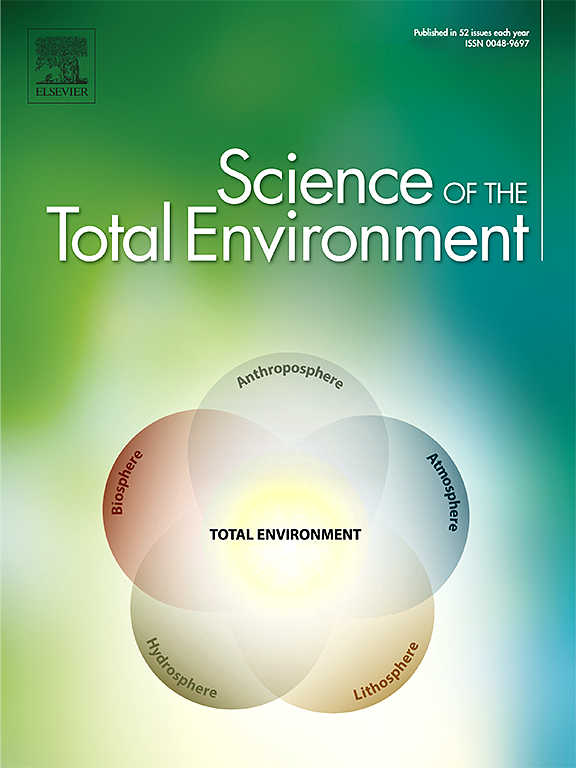熔盐热电效应在生物质富氢气制备、多孔生物炭及熔盐再生中的应用。
IF 8.2
1区 环境科学与生态学
Q1 ENVIRONMENTAL SCIENCES
引用次数: 0
摘要
生物质热解制氢具有吸引力,因为它允许通过原料和热转换实现绿色制氢。然而,制氢的关键限制因素是高氧含量,生物质颗粒在缓慢加热过程中加热不均匀,以及低反应温度(低产气量和低氢含量)导致的解聚不足。为了解决这些问题,本文在NaOH-Na2CO3熔盐中进行了450°C、550°C和650°C的快速热解。考虑到熔盐消耗带来的可持续运行和环境问题,提出了利用电化学电解再生熔盐的方法。实验结果表明,在650℃下,生物质在碱性熔盐中的热转化可以制备出丰富的氢气,同时就地捕获CO2。与常规(无盐)热解相比,H2在熔融盐中的热解率从13.11%提高到81.53%,CO2从28.68%降低到2.07%。值得注意的是,气体中H的质量超过生物质中H的量的1.67倍。这表明熔盐参与了生物质转化。此外,该熔融盐热解体系制备的热解碳(PC)具有较高的比表面积(1960.07m2/g),羟基官能团较多。电化学熔盐再生过程中还会产生一些碳物质,这是由于C组分(C、CO、CO2)进入熔盐后产生的CO32-重新分离形成OH-和C。实验结果表明,NaOH的再生率达到24.76%。熔盐热化学与电化学的耦合实现了低碳资源的碳负利用,本研究为熔盐的再生/循环利用和废熔盐的高价值利用等熔盐的持续应用提供了实践指导。本文章由计算机程序翻译,如有差异,请以英文原文为准。

Application of molten salt thermoelectric effect in biomass preparation of hydrogen-rich gas, porous biochar and molten salt regeneration
Hydrogen production from biomass pyrolysis is attractive since it allows for green hydrogen production through feedstock and thermal conversion. However, the key limiting factors for hydrogen production are the high oxygen content, uneven heating of biomass pellets during the slow heating process, and insufficient depolymerization due to low reaction temperatures (low gas yields and low hydrogen content). To address these challenges, fast pyrolysis of super Arundo in NaOH-Na2CO3 molten salt was carried out in this paper at 450 °C, 550 °C and 650 °C. Considering the sustainable operation and environmental problems caused by the consumption of molten salt, electrochemical electrolysis was proposed to regenerate the molten salt. The experimental results show that at 650 °C, the thermal conversion of biomass in the alkaline molten salt can prepare abundant hydrogen and simultaneously capture CO2 in situ. Compared to conventional (salt-free) pyrolysis, the percentage of H2 pyrolysis in molten salt increased from 13.11 % to 81.53 %, while CO2 decreased from 28.68 % to 2.07 %. It is noted that the mass of H in the gas exceeds the amount of H in the biomass by a factor of 1.67. This indicates that the molten salt was involved in the biomass conversion. Besides, the pyrolyzed carbon (PC) prepared in this molten salt pyrolysis system has a high specific surface area (1960.07m2/g) with many hydroxyl functional groups. Some carbon material is also produced during electrochemical molten salt regeneration, resulting from CO32− generated from the C component (C, CO, CO2) entering the molten salt and re-separated to form OH- and C. Experimental results exhibit that the regeneration ratio of NaOH reaches 24.76 %. The coupling of molten salt thermochemistry and electrochemistry realized carbon-negative utilization of low-carbon resources, this study provides practical guidance for the continuous application of molten salt including regeneration/recycling of molten salt and high-value utilization of waste molten salt.
求助全文
通过发布文献求助,成功后即可免费获取论文全文。
去求助
来源期刊

Science of the Total Environment
环境科学-环境科学
CiteScore
17.60
自引率
10.20%
发文量
8726
审稿时长
2.4 months
期刊介绍:
The Science of the Total Environment is an international journal dedicated to scientific research on the environment and its interaction with humanity. It covers a wide range of disciplines and seeks to publish innovative, hypothesis-driven, and impactful research that explores the entire environment, including the atmosphere, lithosphere, hydrosphere, biosphere, and anthroposphere.
The journal's updated Aims & Scope emphasizes the importance of interdisciplinary environmental research with broad impact. Priority is given to studies that advance fundamental understanding and explore the interconnectedness of multiple environmental spheres. Field studies are preferred, while laboratory experiments must demonstrate significant methodological advancements or mechanistic insights with direct relevance to the environment.
 求助内容:
求助内容: 应助结果提醒方式:
应助结果提醒方式:


